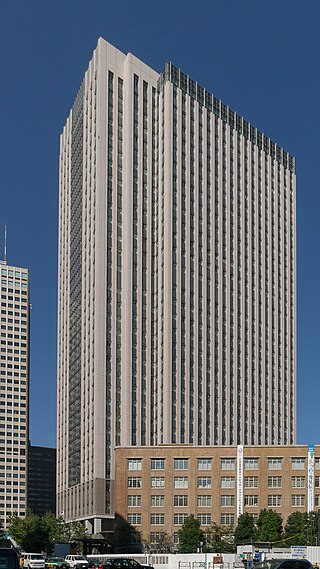Related Research Articles

Nagatachō is a district of Tokyo, Japan, located in Chiyoda Ward. It is the location of the Diet of Japan and the Prime Minister's residence (Kantei). The Supreme Court of Japan is located in neighboring Hayabusachō. Nagatachō is often used to refer to the elected Japanese government, while Kasumigaseki refers to the unelected bureaucratic administration.

The Japan Meteorological Agency (JMA) is an agency of the Ministry of Land, Infrastructure, Transport and Tourism. Headquartered in Minato, Tokyo, the JMA is charged with gathering and providing results to the public that are obtained from data based on daily scientific observation and research into natural phenomena in the fields of meteorology, hydrology, seismology, and volcanology, among other related scientific fields.

The Naikaku Sōri Daijin Kantei (内閣総理大臣官邸) or Prime Minister's Office is the official workplace of the Prime Minister of Japan. It is commonly referred to as Shushō Kantei (首相官邸), or simply Kantei (官邸). Unlike many other famous offices or palaces of heads of states, such as the Kremlin in Russia or the White House in the United States, the Japanese Prime Minister's Office has no nickname. Naikaku Sōri Daijin Kantei literally translates to "Prime Minister's Office" in English.

The Imperial Household Agency (IHA) is an agency of the government of Japan in charge of state matters concerning the Imperial Family, and the keeping of the Privy Seal and State Seal of Japan. From around the 8th century AD until the Second World War, it was known as the Imperial Household Ministry.

The Ministry of Foreign Affairs is an executive department of the Government of Japan, and is responsible for the country's foreign policy and international relations.

The Ministry of Education, Culture, Sports, Science and Technology is one of the eleven ministries of Japan that composes part of the executive branch of the government of Japan. Its goal is to improve the development of Japan in relation with the international community. The ministry is responsible for funding research under its jurisdiction, some of which includes: children's health in relation to home environment, delta-sigma modulations utilizing graphs, gender equality in sciences, neutrino detection which contributes to the study of supernovas around the world, and other general research for the future.

The National Police Agency is the central coordinating law enforcement agency of the Japanese police system. Unlike national police in other countries, the NPA does not have any operational units of its own aside from the Imperial Guard; rather, it is responsible for supervising Japan's 47 prefectural police departments and determining their general standards and policies, though it can command police agencies under it in national emergencies or large-scale disasters. It is under the National Public Safety Commission of the Cabinet Office.

The Ministry of Defense is an executive department of the Government of Japan responsible for preserving the peace and independence of Japan, and maintaining the country's national security and the Japan Self-Defense Forces.

The Army Ministry, also known as the Ministry of War, was the cabinet-level ministry in the Empire of Japan charged with the administrative affairs of the Imperial Japanese Army (IJA). It existed from 1872 to 1945.

The Ministries of Japan or Government Agencies of Japan are the most influential part of the executive branch of the Government of Japan. Each ministry is headed by a Minister of State appointed by the Prime Minister. In postwar politics, the posts of ministers have been given to senior legislators, mostly of the LDP. However, few ministers serve for more than one or two years to develop the necessary grasp of the organisation to become really influential. Thus, most of the power lies within the ministries, with the senior bureaucrats.

Censorship in the Empire of Japan was a continuation of a long tradition beginning in the feudal period of Japan. Government censorship of the press existed in Japan during the Edo period, as the Tokugawa bakufu was in many ways a police state, which sought to control the spread of information, including Christianity, the influx of Western ideas, pornography and any political writings critical of the shōgun and government.

Tsurumi-ku (鶴見区) is one of the 18 ku (wards) of the city of Yokohama in Kanagawa Prefecture, Japan. As of 2010, the ward had an estimated population of 270,433 and a density of 8,140 persons per km². The total area is 33.23 km².
Kudanminami (九段南) is a district of Chiyoda, Tokyo, Japan, consisting of 1-chōme to 4-chōme. As of March 1, 2007, its population is 2,431.

The Government of Japan consists of legislative, executive and judiciary branches and is based on popular sovereignty. The Government runs under the framework established by the Constitution of Japan, adopted in 1947. It is a unitary state, containing forty-seven administrative divisions, with the Emperor as its Head of State. His role is ceremonial and he has no powers related to the Government. Instead, it is the Cabinet, comprising the Ministers of State and the Prime Minister, that directs and controls the Government and the civil service. The Cabinet has the executive power and is formed by the Prime Minister, who is the Head of Government. The Prime Minister is nominated by the National Diet and appointed to office by the Emperor.

Chiyoda, known as Chiyoda City in English, is a special ward of Tokyo, Japan. Located in the heart of Tokyo's 23 special wards, Chiyoda consists of the Imperial Palace and a surrounding radius of about a kilometer, and is known as the political and financial center of Japan. As of October 2020, the ward has a population of 66,680, and a population density of 5,709 people per km2, making it by far the least populated of the special wards. The total area is 11.66 km2, of which the Imperial Palace, Hibiya Park, National Museum of Modern Art, and Yasukuni Shrine take up approximately 2.6 km2, or 22% of the total area.

The Statistics Bureau of Japan or SB/SBJ is the statistical agency of Japan, subordinate to the Ministry of Internal Affairs and Communications (MIC). The SBJ have conducted the Population Census and large-scale surveys to establish key official statistics of Japan. It is also in charge of the management of the public online system of official statistics, international cooperation with other countries' statistics offices, and research and publication regarding statistics. Its headquarters is in the ministry's Second Government Office (第2庁舎), in Wakamatsu-cho, Shinjuku, Tokyo, near Wakamatsu-kawada Station of the subway Toei Ōedo Line. The National Statistics Center (NSTAC) and the MIC Director-General for Policy Planning are in the same building.

The Permanent General Mission of Palestine in Tokyo is the de facto embassy of Palestine in Japan. There is no official diplomatic relations between the two nations as Japan doesn't recognize Palestine as a sovereign state. Even though the Japanese government supports a two-state solution, the status quo over diplomatic relations persisted over the years with periodic state visits between the two nations. Japan operates a representative office in Ramallah.

The Chief of Protocol (CoP) is a government official who heads the protocol department of a state, overseeing security, logistics and etiquette in diplomatic and national functions. A protocol department decides on diplomatic immunity and privileges, diplomatic host security, diplomatic use of airspace and it is the guardian of official etiquette. Advance protocol teams, usually headed by the Chief of Protocol, engage as first contact between governments for the planning of bilateral and multilateral summits and visits.
References
- ↑ pp 102-108, "Government: The Executive Departments," Japan Year Book 1938-1939, Kenkyusha Press, Foreign Association of Japan, Tokyo
